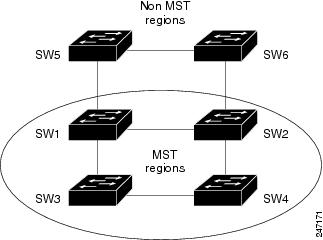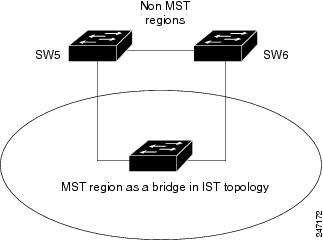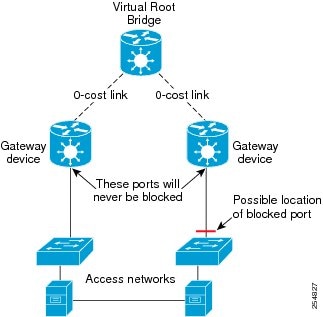This example shows
MSTP configuration for a single spanning-tree instance with MSTP enabled on a
single interface:
config
spanning-tree mst example
name m1
revision 10
forward-delay 20
maximum hops 40
maximum age 40
transmit hold-count 8
provider-bridge
bringup delay for 60 seconds
flush containment disable
instance 101
vlans-id 101-110
priority 8192
!
interface GigabitEthernet0/0/0/0
hello-time 1
external-cost 10000
link-type point-to-point
portfast
guard root
guard topology-change
instance 101 cost 10000
instance 101 port-priority 160
!
!
This example shows
the output from the
show spanning-tree mst command, which
produces an overview of the spanning tree protocol state:
# show spanning-tree mst example
Role: ROOT=Root, DSGN=Designated, ALT=Alternate, BKP=Backup, MSTR=Master
State: FWD=Forwarding, LRN=Learning, BLK=Blocked, DLY=Bringup Delayed
Operating in dot1q mode
MSTI 0 (CIST):
VLANS Mapped: 1-9,11-4094
CIST Root Priority 4096
Address 6262.6262.6262
This bridge is the CIST root
Ext Cost 0
Root ID Priority 4096
Address 6262.6262.6262
This bridge is the root
Int Cost 0
Max Age 20 sec, Forward Delay 15 sec
Bridge ID Priority 4096 (priority 4096 sys-id-ext 0)
Address 6262.6262.6262
Max Age 20 sec, Forward Delay 15 sec
Max Hops 20, Transmit Hold count 6
Interface Port ID Role State Designated Port ID
Pri.Nbr Cost Bridge ID Pri.Nbr
------------ ------- --------- ---- ----- -------------------- -------
Gi0/0/0/0 128.1 20000 DSGN FWD 4096 6262.6262.6262 128.1
Gi0/0/0/1 128.2 20000 DSGN FWD 4096 6262.6262.6262 128.2
Gi0/0/0/2 128.3 20000 DSGN FWD 4096 6262.6262.6262 128.3
Gi0/0/0/3 128.4 20000 ---- BLK ----- -------------- -------
MSTI 1:
VLANS Mapped: 10
Root ID Priority 4096
Address 6161.6161.6161
Int Cost 20000
Max Age 20 sec, Forward Delay 15 sec
Bridge ID Priority 32768 (priority 32768 sys-id-ext 0)
Address 6262.6262.6262
Max Age 20 sec, Forward Delay 15 sec
Max Hops 20, Transmit Hold count 6
Interface Port ID Role State Designated Port ID
Pri.Nbr Cost Bridge ID Pri.Nbr
------------ ------- --------- ---- ----- -------------------- -------
Gi0/0/0/0 128.1 20000 ROOT FWD 4096 6161.6161.6161 128.1
Gi0/0/0/1 128.2 20000 ALT BLK 4096 6161.6161.6161 128.2
Gi0/0/0/2 128.3 20000 DSGN FWD 32768 6262.6262.6262 128.3
Gi0/0/0/3 128.4 20000 ---- BLK ----- -------------- -------
=========================================================================
In the
show spanning-tree mst example output, the
first line indicates whether MSTP is operating in dot1q or the Provider Bridge
mode, and this information is followed by details for each MSTI.
For each MSTI, the
following information is displayed:
-
The list of
VLANs for the MSTI.
-
For the CIST,
the priority and bridge ID of the CIST root, and the external path cost to
reach the CIST root. The output also indicates if this bridge is the CIST root.
-
The priority and
bridge ID of the root bridge for this MSTI, and the internal path cost to reach
the root. The output also indicates if this bridge is the root for the MSTI.
-
The max age and
forward delay times received from the root bridge for the MSTI.
-
The priority and
bridge ID of this bridge, for this MSTI.
-
The maximum age,
forward delay, max hops and transmit hold-count for this bridge (which is the
same for every MSTI).
-
A list of
MSTP-enabled interfaces. For each interface, the following information is
displayed:
-
The
interface name
-
The port
priority and port ID for this interface for this MSTI.
-
The port
cost for this interface for this MSTI.
-
The current
port role:
-
DSGN—Designated: This is the designated port on this LAN, for
this MSTI
-
ROOT—Root: This is the root port for the bridge for this MSTI.
-
ALT—Alternate: This is an alternate port for this MSTI.
-
BKP—Backup: This is a backup port for this MSTI
-
MSTR—Master: This is a boundary port that is a root or alternate
port for the CIST.
The
interface is down, or the bringup delay timer is running and no role has been
assigned yet.
-
The current
port state:
-
BLK—The
port is blocked.
-
LRN—The
port is learning.
-
FWD—The
port is forwarding.
-
DLY—The
bringup-delay timer is running.
-
If the port
is a boundary port, and not CIST and the port is not designated, then only the
BOUNDARY PORT is displayed and the remaining information is not displayed.
-
If the port
is not up, or the bringup delay timer is running, no information is displayed
for the remaining fields. Otherwise, the bridge priority and bridge ID of the
designated bridge on the LAN that the interface connects to is displayed,
followed by the port priority and port ID of the designated port on the LAN. If
the port role is Designated, then the information for this bridge or port is
displayed.
The following
example shows the output from the
show spanning-tree mst command, which
produces more detailed information regarding interface state than the standard
command as described above:
# show spanning-tree mst a interface GigabitEthernet0/1/2/1
GigabitEthernet0/1/2/1
Cost: 20000
link-type: point-to-point
hello-time 1
Portfast: no
BPDU Guard: no
Guard root: no
Guard topology change: no
BPDUs sent 492, received 3
MST 3:
Edge port:
Boundary : internal
Designated forwarding
Vlans mapped to MST 3: 1-2,4-2999,4000-4094
Port info port id 128.193 cost 200000
Designated root address 0050.3e66.d000 priority 8193 cost 20004
Designated bridge address 0002.172c.f400 priority 49152 port id 128.193
Timers: message expires in 0 sec, forward delay 0, forward transitions 1
Transitions to reach this state: 12
The output includes
interface information about the interface which applies to all MSTIs:
It also includes
information specific to each MSTI:
-
Port ID,
priority, cost
-
BPDU information
from root (bridge ID, cost, and priority)
-
BPDU information
being sent on this port (Bridge ID, cost, priority)
-
State
transitions to reach this state.
-
Topology changes
to reach this state.
-
Flush
containment status for this MSTI.
This example shows
the output of
show spanning-tree mst errors, which produces
information about interfaces that are configured for MSTP but where MSTP is not
operational. Primarily this shows information about interfaces which do not
exist:
# show spanning-tree mst a errors
Interface Error
-------------------------------
GigabitEthernet1/2/3/4 Interface does not exist.
This example shows
the output of
show spanning-tree mst configuration, which
displays the VLAN ID to MSTI mapping table. It also displays the configuration
digest which is included in the transmitted BPDUs—this must match the digest
received from other bridges in the same MSTP region:
# show spanning-tree mst a configuration
Name leo
Revision 2702
Config Digest 9D-14-5C-26-7D-BE-9F-B5-D8-93-44-1B-E3-BA-08-CE
Instance Vlans mapped
-------- -------------------------------
0 1-9,11-19,21-29,31-39,41-4094
1 10,20,30,40
------------------------------------------
This example shows
the output of
show spanning-tree mst , which produces
details on the BPDUs being output and received on a given local interface:

Note
|
Several received
packets can be stored in case of MSTP operating on a shared LAN.
|
# show spanning-tree mst a bpdu interface GigabitEthernet0/1/2/2 direction transmit
MSTI 0 (CIST):
Root ID : 0004.9b78.0800
Path Cost : 83
Bridge ID : 0004.9b78.0800
Port ID : 12
Hello Time : 2
...
This example shows
the output of
show spanning-tree mst , which displays
details about the topology changes that have occurred for each MSTI on each
interface:
# show spanning-tree mst M topology-change flushes instance$
MSTI 1:
Interface Last TC Reason Count
------------ -------------------- -------------------------------- -----
Te0/0/0/1 04:16:05 Mar 16 2010 Role change: DSGN to ---- 10
#
#
# show spanning-tree mst M topology-change flushes instance$
MSTI 0 (CIST):
Interface Last TC Reason Count
------------ -------------------- -------------------------------- -----
Te0/0/0/1 04:16:05 Mar 16 2010 Role change: DSGN to ---- 10
#















 Feedback
Feedback